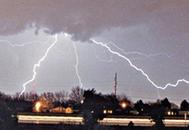- Lightning Safety /
- Personal Safety From Lightning

Personal Safety From Lightning
According to N.F.P.A. (National Fire Protection Association) in the annex to their Lightning Protection Standard NFPA 780, most lightning strike victims are struck either before or after the rain that most often accompanies a thunderstorm. Lightning can “reach out” 10 or more miles from the storm itself.

Most people can figure out it’s a good idea to get in out of the rain, but special care needs to be exercised when lightning comes with the rain.
If thunder is heard, NFPA advises “seek shelter immediately”! These locations include:
- Buildings with code compliant lightning protection systems. (Failing that, inside any sizeable building is better than outside).
- Underground structures (tunnels, subways, etc.)
- Enclosed metal roofed vehicles including cars, buses, trains, etc.
- Enclosed metal boats or ships
- Paved city streets surrounded by tall nearby buildings.

Try to avoid:
- Small shelters (picnic pavilions, bus shelters, etc.)
- Tents
- Convertible top cars
- Open or non-metal trailers

The following locations are very dangerous and should be avoided altogether:
- Hills, ridge tops, and open farm fields
- Roofs of buildings
- Golf courses and other sporting grounds
- Swimming pools (indoor or outdoor) & tennis courts

- Parking lots
- Lakes, rivers, oceans (especially in open boats)
- Next to metal fences, railroad tracks and under isolated trees
- Stay away from metal water pipes, hard wired phones and mechanical equipment as much as possible
To minimize your risk from lightning seek shelter as noted above as quickly as possible.

As a good rule of thumb, wait 30 minutes after the last thunder is heard before resuming your prior outdoor activities.
If, in the unfortunate case you are caught without the opportunity to take shelter:
- Seek low areas
- Seek dense woods, not isolated trees
- If caught in the open, crouch low while kneeling on the ground with your feet together. Put your hands on your thighs. DO NOT put your hands on the ground or lie flat.

If in a boat:
- Stay inside the hull line, not in the water.
- Minimize, to the greatest extent possible, contact with any part of the boat’s lightning protection system or items connected there to.
On a final note, lightning strike victims do not “carry a charge or pose a risk”. Summon help at once and, if trained, perform CPR and first aid at once.

